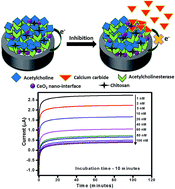Calcium carbide in mangoes: an electrochemical way for detection†
Abstract
Calcium carbide (CaC2), a carcinogen, is widely used for artificial ripening of mangoes. The usage of CaC2 for mango ripening results in serious health issues like neurological disorders, ulcers, hypoxia, memory loss, etc. Identification of artificially ripened mangoes and quantification of CaC2 in such fruits help in prevention of related health problems. The instability of CaC2 in water makes its detection complex. In addition, the diffusion of calcium hydroxide (Ca(OH)2) and acetylene (C2H2) into mangoes makes it more challenging. In this scenario, an electrochemical CaC2 biosensor with a platinum (Pt) working electrode surface modified by a ceria (CeO2) nano-interface and acetylcholinesterase (AChE) enzyme has been developed. The mechanism involves competitive inhibition of the Pt/CeO2/AChE bioelectrode by the mixture of calcium peroxide (CaO2) and C2H2. Different aspects of electrode immobilization with the nano-interface were probed using cyclic voltammetric and amperometric studies. The fabricated Pt/CeO2/AChE bioelectrode exhibited a LOD of 0.6 nM with a linear range of 1–20 nM and % recovery in the range of 97.89–104.82.


 Please wait while we load your content...
Please wait while we load your content...